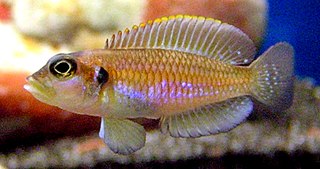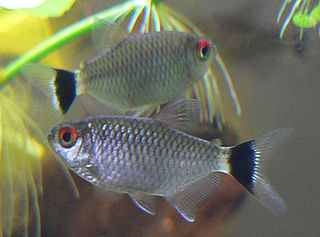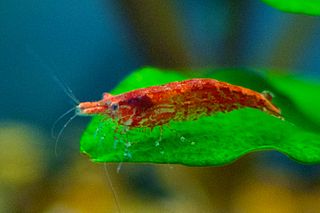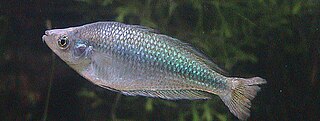
The neon tetra is a vibrant freshwater fish from the Amazon basin, renowned for its bright blue and red stripes, making it a favorite among aquarium hobbyists. In the wild, it inhabits warm, acidic waters in blackwater and clearwater streams, avoiding whitewater rivers. Distinguished by its iridescent coloration, which changes with light conditions, the neon tetra exhibits slight sexual dimorphism in its body shape and stripe curvature. First described in 1936, it is now a staple in the aquarium trade, primarily farm-raised in Southeast Asia. Neon tetras require specific water conditions and thrive in groups within well-planted tanks. They have an omnivorous diet, including small aquatic foods. Breeding in captivity is challenging and they are prone to neon tetra disease, an often fatal condition. Proper care and preventive measures are crucial for their health in aquariums.

The black neon tetra is a freshwater fish of the characin family (Characidae) of the order Characiformes. It is native to the Paraguay basin of southern Brazil. They are often found in the aquarium trade.

Sterba's corydoras is a member of the South American Corydoras genus of freshwater aquarium catfish and one of the most popular species of Corydoras due to its attractive markings. The fish is native to the Guaporé River region between Bolivia and Brazil.

The Congo tetra is a species of fish in the African tetra family, found in the central Congo River Basin in Africa. It is commonly kept in aquaria.

Rainbowfishes are small, colourful freshwater fishes belonging to the family Melanotaeniidae, found in northern and eastern Australia, New Guinea, Sulawesi and Madagascar.

Aquarium fish feed is plant or animal material intended for consumption by pet fish kept in aquariums or ponds. Fish foods normally contain macronutrients, trace elements and vitamins necessary to keep captive fish in good health. Approximately 80% of fishkeeping hobbyists feed their fish exclusively prepared foods that most commonly are produced in flake, pellet or tablet form. Some fish foods also contain additives such as sex hormones or beta carotene to artificially enhance the color of ornamental fish.

The pygmy gourami, also known as the sparkling gourami, is a freshwater species of gourami native to Southeast Asia.

The Buenos Aires tetra is a tropical fish from South America. It was first observed in the wild in 1907, by Carl H. Eigenmann.

Lamprologus ocellatus is a species of shell dwelling cichlid endemic to Lake Tanganyika. It is a popular aquarium fish due to its small size, appearance, and intelligence.

Hemigrammus erythrozonus, commonly known as the glowlight tetra, is a small tropical fish from the Essequibo River, Guyana, South America. It is silver in colour and a bright iridescent orange to red stripe extends from the snout to the base of its tail, the front of the dorsal fin being the same color as the stripe. Other fins are silver to transparent. The glowlight tetra is a peaceful, shoaling fish. It is larger than the neon tetra, and its peaceful disposition makes it an ideal, and popular, community tank fish. It should be kept with similar sized, non-aggressive species. Hemigrammus gracilis is a senior synonym. The red-line rasbora of Malaysia and Indonesia has markings and coloring very similar to H. erythrozonus, but is a member of family Cyprinidae, not a close relative.

Hyphessobrycon columbianus is a species of Tropical freshwater fish of the characin family. The Colombian tetra is native to the Acandi River near Acandí) in northwestern Colombia. The Colombian tetra's habitat tends to be slow-flowing creeks and tributaries.

The redeye tetra, is a species of tetra from the São Francisco, upper Paraná, Paraguay and Uruguay river basins in eastern and central South America. This freshwater fish is commonly kept in aquariums and bred in large numbers at commercial facilities in Eastern Europe and Asia. The redeye tetra is one of the more popular aquarium fish due to their schooling capability.

The dwarf rainbowfish is a species of rainbowfish in the subfamily Melanotaeniinae. It is known under a number of common names including diamond rainbowfish, neon rainbowfish, Praecox rainbowfish, dwarf neon rainbowfish, peacock rainbowfish, and Teczanka neonowa. It is endemic to the Mamberamo River basin in West Papua in Indonesia and common in the aquarium trade.

Neocaridina davidi is a freshwater shrimp originating from eastern China and northern Taiwan and introduced in the rest of Taiwan, Japan, and Hawaii, which is commonly kept in aquaria. The natural coloration of the shrimp is green-brown. There are a wide range of colors including red, yellow, orange, green, blue, violet, black, etc.; however, the red morph is more frequently sold. The density of coloration on adult shrimp, dependent on breeding, determines their sale price and "quality" (grading). This "quality" is purely aesthetic, as the size, behavior and other characteristics of the animal are more or less equal across varieties. Full-grown shrimp reach about 4 centimetres (1.6 in) long. They prefer clean water, with a pH of 6.5-8, and a temperature of 14–29 °C (57–84 °F) They are most comfortable at 22 °C (72 °F). N. davidi shrimp are omnivores that may live 1–2 years. These shrimps have previously been classified as Neocaridina heteropoda and Neocaridina denticulata sinensis, however are now known as Neocaridina davidi which is based on the oldest known published description of the species.

The Murray River rainbowfish, known less commonly as the Australian rainbowfish, is a species of freshwater fish endemic to southeastern Australia. The southernmost species of all rainbowfishes, these fish are very colourful, hence the name; and there is sexual dimorphism with the males being larger and more colourful than females. Murray River rainbowfish are schooling fish and will congregate near logs or riverbanks, and are a popular aquarium fish.

The ember tetra is a freshwater fish of the characin family of order Characiformes. It is native to the Araguaia River basin of Brazil and was discovered in 1987 and named in honor of the fish explorer Heiko Bleher's mother.

The violet goby is a species of goby native to marine, fresh and brackish waters near the Atlantic coast of North and South America from South Carolina in the United States of America, to northern Brazil. It prefers bays, estuaries and river mouths with muddy substrates. It is often marketed as the dragon goby or dragon fish.

The White Cloud Mountain minnow is a hardy species of freshwater fish and coldwater fish often kept in an aquarium. The species is a member of the carp family of the order Cypriniformes, native to China. The White Cloud Mountain minnow is practically extinct in its native habitat, due to pollution and tourism. It was believed to be extinct for over 20 years in 1980, but an apparently native population of this fish was discovered on Hainan Island, well away from the White Cloud Mountain. They are bred in farms and are easily available through the aquarium trade. However, inbreeding in farms has led to genetically weak stock that is vulnerable to disease and prone to physical deformities.

The banded rainbowfish, also known as the Jewel rainbowfish,Goyder River rainbowfish,three-striped sunfish or regal rainbowfish, is a species of Rainbowfish found in the northerly regions of North Australia and Queensland. an adult Banded Rainbowfish can reach a stranded length of 15 cm -12 cm with a deep body usually exceeding 1/3 of their body length, like most Rainbowfish banded Rainbowfish vary in colour depending on where they were collected, but all variety's have a distinct dark mid-lateral band and bright red/yellow Dorsal, anal, and caudal fins.





















